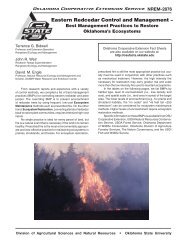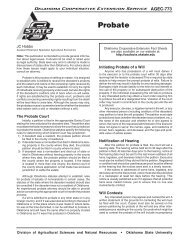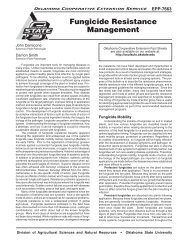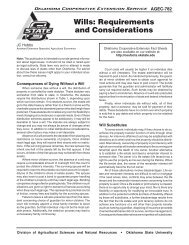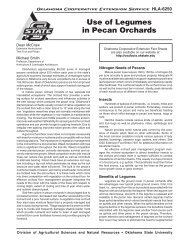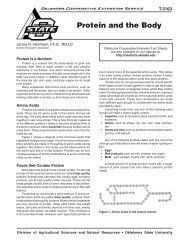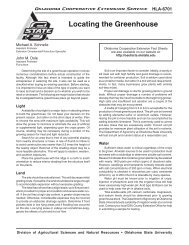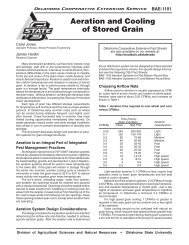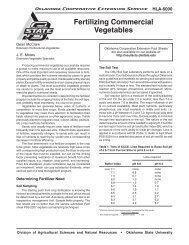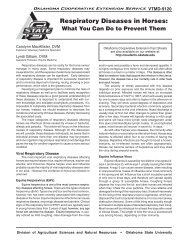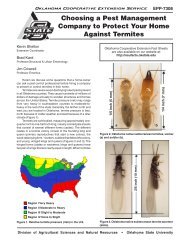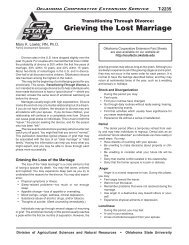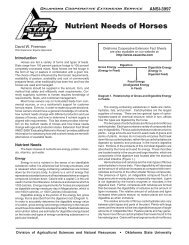Common Insect and Mite Pests of Small Grains - OSU Fact Sheets ...
Common Insect and Mite Pests of Small Grains - OSU Fact Sheets ...
Common Insect and Mite Pests of Small Grains - OSU Fact Sheets ...
You also want an ePaper? Increase the reach of your titles
YUMPU automatically turns print PDFs into web optimized ePapers that Google loves.
Oklahoma Cooperative Extension Service<br />
EPP-7176<br />
<strong>Common</strong> <strong>Insect</strong> <strong>and</strong> <strong>Mite</strong> <strong>Pests</strong><br />
<strong>of</strong> <strong>Small</strong> <strong>Grains</strong><br />
Tom A. Royer<br />
Extension Entomologist<br />
Norm C. Elliott<br />
USDA Research Biologist<br />
Kristopher L. Giles<br />
Research Entomologist<br />
Oklahoma Cooperative Extension <strong>Fact</strong> <strong>Sheets</strong><br />
are also available on our website at:<br />
http://osufacts.okstate.edu<br />
Many insects feed on small grains but most do not cause<br />
significant damage. Major pest outbreaks are infrequent, but in<br />
any given year, some fields will require an insecticide application<br />
in order to control a pest outbreak. During severe outbreak years,<br />
insecticides may be applied to millions <strong>of</strong> acres. The decision to<br />
apply an insecticide for control <strong>of</strong> a pest is important because <strong>of</strong><br />
the narrow pr<strong>of</strong>it margins in small grains <strong>and</strong> continued concern<br />
about pesticide misuse in the environment. Therefore, they<br />
should be used only when necessary. The use <strong>of</strong> a well designed<br />
Integrated Pest Management (IPM) program can greatly aid in<br />
making economically <strong>and</strong> environmentally responsible decisions<br />
on the use <strong>of</strong> pesticides.<br />
Field scouting, or pest monitoring is a cornerstone <strong>of</strong> any<br />
effective IPM program, <strong>and</strong> begins with correct identification <strong>of</strong> the<br />
pest. Crop pests can be identified through a combination <strong>of</strong> direct<br />
recognition, knowing something about the biology <strong>and</strong> habits <strong>of</strong><br />
the pest, <strong>and</strong> recognizing injury symptoms on the plant. Scouting<br />
does not have to be time consuming, but should provide enough<br />
information to make an economically sensible decision.<br />
IPM programs should be based on solid research-based<br />
information, be flexible in practice, <strong>and</strong> include a suitable combination<br />
<strong>of</strong> biological, cultural <strong>and</strong> mechanical control methods.<br />
As a rule, pesticides should be used as a corrective tool that<br />
targets a specific pest present in economically damaging numbers.<br />
The following information is intended as a guide for identifying,<br />
scouting, <strong>and</strong> managing small grain insect <strong>and</strong> mite pests in<br />
Oklahoma.<br />
Aphids<br />
Greenbug<br />
Russian Wheat Aphid<br />
Bird cherry-oat aphid<br />
Rice root aphid<br />
Corn leaf aphid<br />
English grain aphid<br />
(Schizaphis graminum)<br />
(Diuraphis noxia)<br />
(Rhopalosiphum padi)<br />
(Rhopalosiphum rufiabdominalis)<br />
(Rhopalosiphum maidis)<br />
(Sitobion avenae)<br />
Aphids (Plate 1) can be found on wheat virtually from<br />
emergence to harvest. They feed by inserting their needlelike<br />
mouthparts into the plant <strong>and</strong> sucking plant juices. The greenbug<br />
<strong>and</strong> Russian wheat aphid both inject saliva that contains plant<br />
toxins. The bird-cherry oat aphid does not have toxins in its saliva,<br />
but causes yield loss <strong>and</strong> it is a primary vector <strong>of</strong> the virus that<br />
causes Barley Yellow Dwarf disease.<br />
The greenbug is a s<strong>of</strong>t-bodied, lime-green colored insect with<br />
a darker green stripe on its back. The outer half <strong>of</strong> its antennae<br />
<strong>and</strong> legs are black as well as the tips <strong>of</strong> its cornicles (cornicles<br />
are twin projections that resemble exhaust pipes, <strong>and</strong> are located<br />
on the upper rear <strong>of</strong> the insect).<br />
The Russian wheat aphid is a relatively new arrival to<br />
Oklahoma, <strong>and</strong> occurs primarily in far-western Oklahoma <strong>and</strong><br />
the Panh<strong>and</strong>le. An adult Russian wheat aphid is about 1/16 inch<br />
long, pale green in color with a waxy appearance <strong>and</strong> “spindle<br />
shaped.” It has short antennae but no prominent cornicles; a<br />
projection above the “tail” gives it a “double tail” appearance.<br />
This aphid overwinters in the southern part <strong>of</strong> the wheat belt,<br />
<strong>and</strong> migrates northward each year. It is primarily a pest <strong>of</strong> wheat<br />
<strong>and</strong> barley, <strong>and</strong> will most likely be found during the spring.<br />
The bird cherry-oat aphid occurs in the fall <strong>and</strong> spring.<br />
Wingless bird cherry-oat aphids are distinguished from the<br />
greenbug by their olive-green color <strong>and</strong> a red-orange patch surrounding<br />
the base <strong>of</strong> each cornicle. “Old” aphids found in winter<br />
<strong>and</strong> early spring may have totally black bodies, but they will give<br />
birth to more typical aphids in the spring. Bird cherry-oat aphid<br />
is a very efficient vector <strong>of</strong> the virus that causes Barley Yellow<br />
Dwarf (BYD) disease. A close relative, the rice root aphid, is<br />
<strong>of</strong>ten found feeding on the crown roots <strong>of</strong> young wheat seedlings<br />
in early fall <strong>and</strong> can also cause yield loss <strong>and</strong> transmit the BYD<br />
virus.<br />
The corn leaf aphid is bluish-green, with short, black cornicles<br />
<strong>and</strong> black antennae <strong>and</strong> legs. It is more likely to be found<br />
in sorghum or corn, but may occur in seedling wheat in autumn<br />
or on mature plants in late spring through summer.<br />
The English grain aphid is larger than the greenbug <strong>and</strong><br />
has a “spidery” appearance because <strong>of</strong> its long legs <strong>and</strong> narrow,<br />
long cornicles. The body <strong>of</strong> the English grain aphid is green but<br />
both cornicles <strong>and</strong> legs are completely black. It is commonly<br />
found in the heads <strong>of</strong> wheat, but seldom reduces yield <strong>and</strong><br />
generally does not require control.<br />
Because aphids can reproduce rapidly, they can seemingly<br />
become a problem “overnight.” They can disappear just as<br />
quickly because they are very susceptible to death from adverse<br />
climate or natural enemies. Not all the cereal aphids present<br />
in wheat pose a serious threat for yield loss, so it is important<br />
to correctly identify the aphid, <strong>and</strong> accurately assess through<br />
sampling, the need for control. For more detailed information on<br />
aphid management <strong>and</strong> sampling in small grains, consult <strong>OSU</strong><br />
<strong>Fact</strong> Sheet EPP-7183, <strong>Small</strong> Grain Aphids in Oklahoma.<br />
Caterpillars<br />
Armyworm<br />
Army Cutworm<br />
Fall Armyworm<br />
Pale Western Cutworm<br />
(Pseudaletia unipuncta)<br />
(Euxoa auxiliaris)<br />
(Spodoptera frugiperda)<br />
(Agrotis orthogonia)<br />
The armyworm is also called the “true armyworm” to distinguish<br />
it from the army cutworm <strong>and</strong> the fall armyworm. The<br />
armyworm typically becomes a pest <strong>of</strong> wheat at heading. It prefers<br />
“green” tissue, feeding first on the leaves, then on the beards <strong>and</strong><br />
finally on the kernels. The most obvious direct damage to wheat<br />
is “head clipping,” when caterpillars chew completely through<br />
Division <strong>of</strong> Agricultural Sciences <strong>and</strong> Natural Resources • Oklahoma State University
the stem <strong>and</strong> the head falls <strong>of</strong>f the plant. Head clipping is not<br />
a major problem in most years. However, a heavy population<br />
may destroy the leaves <strong>and</strong>/or beards in only a few nights <strong>of</strong><br />
feeding, <strong>and</strong> cause indirect yield loss.<br />
Armyworms overwinter as partially grown caterpillars in grass<br />
pastures or on grassy weed hosts. Adult moths emerge in early<br />
spring (late March <strong>and</strong> April) <strong>and</strong> lay eggs in wheat fields. Mature<br />
larvae measure 1 1/2 inches long, are smooth bodied, <strong>and</strong> dark<br />
gray to greenish black in color (Plate 2). The most distinguishing<br />
feature on this insect is the presence <strong>of</strong> five stripes extending<br />
lengthwise along the body; three on its back, <strong>and</strong> one on each<br />
side.<br />
Armyworms are not easily seen because they hide in the<br />
soil during the day <strong>and</strong> feed on the leaves <strong>and</strong> heads at night.<br />
Heaviest infestations will more likely occur near field margins <strong>and</strong><br />
in low-lying areas <strong>of</strong> rank growth or where plants have lodged.<br />
Look for this insect in <strong>and</strong> under debris at the base <strong>of</strong> plants. The<br />
presence <strong>of</strong> frass (feces) <strong>and</strong> dropped plant material indicates<br />
ongoing feeding activity. When scouting, examine several locations<br />
within the field <strong>and</strong> take an average <strong>of</strong> worm counts.<br />
Armyworms should be examined closely for size <strong>and</strong> the<br />
presence <strong>of</strong> small white eggs attached to their “neck,” just behind<br />
the head capsule. Large armyworms over 1 1/4 inches long are<br />
mature. The white eggs are laid by a fly parasite. If most caterpillars<br />
are large or many have eggs, treatment is probably not<br />
necessary. The treatment threshold is three to four unparasitized<br />
armyworms per linear foot <strong>of</strong> row.<br />
Army cutworm is a sporadic pest <strong>of</strong> small grains in Oklahoma,<br />
but causes widespread losses during outbreak years. Heaviest<br />
damage occurs in late winter <strong>and</strong> spring after temperatures<br />
increase. Damaging infestations are more likely to occur during<br />
dry years when plant growth conditions are below optimum.<br />
The adult army cutworm moths fly in from mountainous<br />
summering grounds in the fall <strong>and</strong> lays eggs, preferring bare<br />
soil. Larvae hatch <strong>and</strong> feed on new growth in the fall, probably<br />
molting once or twice before spring. Larvae overwinter in the soil,<br />
<strong>and</strong> are quite capable <strong>of</strong> surviving extreme cold weather. Army<br />
cutworm larvae have a gray-striped appearance, <strong>and</strong> will molt<br />
seven times before pupating. When disturbed, they exhibit the<br />
typical curling into a tight “C” shape (Plate 3). They quit feeding<br />
<strong>and</strong> pupate sometime in April. Adult moths emerge in May, <strong>and</strong><br />
migrate to the Rocky Mountains to spend the summer, returning<br />
to the Great Plains the next fall. One generation occurs each<br />
year.<br />
Fields should be checked regularly for this insect, especially<br />
during dry winters when the wheat is stressed. Infested fields<br />
<strong>of</strong>ten seem to “slowly disappear” as army cutworms feed <strong>and</strong><br />
grow. Fields should be checked by digging or stirring the soil to<br />
a depth <strong>of</strong> two inches <strong>and</strong> counting cutworms that are exposed.<br />
You can focus sampling efforts on “hot spots” in the field, but<br />
make sure you have a representative sample <strong>of</strong> the whole field<br />
before making a treatment decision. If army cutworms are found,<br />
the treatment threshold is two to three worms per linear foot <strong>of</strong><br />
row if the wheat is small <strong>and</strong> water stressed, <strong>and</strong> four to five if<br />
the wheat has adequate water <strong>and</strong> is growing vigorously.<br />
The fall armyworm can be found in wheat from September<br />
through frost, <strong>and</strong> is capable <strong>of</strong> injuring seedling wheat plants.<br />
Mature caterpillars are 1 1/2 inches long <strong>and</strong> brown, green or<br />
black in color <strong>and</strong> have a prominent inverted white “Y”- shaped<br />
line on the front <strong>of</strong> the head (Plate 4). The eggs are laid at night<br />
on grasses or other plants <strong>and</strong> hatch in a few days. Caterpillars<br />
mature in three weeks <strong>and</strong> there are several generations<br />
in Oklahoma each year.<br />
Check for larvae in several locations within the field. Young<br />
larvae will not chew completely through a leaf <strong>and</strong> will leave a<br />
“windowpane” like injury. Note any “windowpaning” that occurs<br />
as you scout. When scouting, it is important to check the interior<br />
<strong>of</strong> the field as well as the field margins. Frequently, this insect<br />
is numerous along field margins, <strong>and</strong> a perimeter insecticide<br />
treatment may be all that is needed.<br />
Fall armyworms rarely occur in large enough numbers to<br />
cause economic injury, but early planted fields are at greatest<br />
risk. In seedling wheat, the treatment threshold is two to three<br />
larvae per linear foot <strong>of</strong> row. As plants get older, the treatment<br />
threshold is three to four larvae per foot <strong>of</strong> row if accompanied<br />
with evidence <strong>of</strong> obvious foliage loss.<br />
Pale western cutworm is an occasional pest <strong>of</strong> wheat in<br />
the Oklahoma panh<strong>and</strong>le. Larvae are shiny, gray to creamcolored,<br />
<strong>and</strong> feed below the soil surface. Their biology is very<br />
similar to the army cutworm, but they usually occur two to three<br />
weeks later in the growing season. Scout by scratching the soil<br />
surface at least two inches deep to look for larvae. The treatment<br />
threshold is two or more larvae per linear foot <strong>of</strong> row.<br />
False Wireworm (Tenebrionidae)<br />
False wireworms are a yellow-brown colored, soil-dwelling,<br />
hard-shelled, wormlike stage <strong>of</strong> darkling beetles that feed directly<br />
on seeds or newly germinated plants (Plate 5). They tend to<br />
cause the most severe injury when seeds are planted into dry<br />
soil <strong>and</strong> do not receive an activating rainfall for several weeks.<br />
Because wireworm numbers <strong>and</strong> damage are <strong>of</strong>ten associated<br />
with dry conditions, drought is sometimes blamed for st<strong>and</strong><br />
loss caused by this insect. A number <strong>of</strong> false wireworm species<br />
occur in Oklahoma. Adults are active in late summer, <strong>and</strong> large<br />
numbers <strong>of</strong> these beetles are a sign that false wireworms may<br />
be a problem.<br />
False wireworms can be detected by sifting several one<br />
square foot samples <strong>of</strong> soil to a depth <strong>of</strong> three inches <strong>and</strong> searching<br />
for the larvae. If two or more larvae are found per square<br />
foot <strong>of</strong> soil, then a registered insecticide seed treatment should<br />
be considered.<br />
Hessian Fly (Mayetiola destructor)<br />
Hessian fly may occur throughout the eastern <strong>and</strong> central<br />
parts <strong>of</strong> Oklahoma in limited numbers. The adult female is a<br />
tiny, fragile-looking fly measuring less than 1/8 inches. Two<br />
generations occur, one in late summer through fall, <strong>and</strong> another<br />
in the spring. This insect overwinters <strong>and</strong> oversummers as a<br />
mature larva in a dark brown puparium called a “flaxseed” (Plate<br />
6). Plants that are injured during the fall will die in the spring,<br />
<strong>and</strong> injury may be mistaken for winterkill. If infestations occur<br />
in the spring, stem heads may lodge or break.<br />
Hessian fly can be managed with cultural practices that<br />
include:<br />
• Destruction <strong>of</strong> plant stubble after harvest<br />
• Controlling volunteer wheat<br />
• Resistant varieties<br />
• Planting after the fly-free date in northern Oklahoma.<br />
<strong>Mite</strong>s<br />
Brown Wheat <strong>Mite</strong><br />
Wheat Curl <strong>Mite</strong><br />
Winter Grain <strong>Mite</strong><br />
(Petrobia latens)<br />
(Aceria tosichella)<br />
(Penthaleus major)<br />
<strong>Mite</strong>s, while not insects, are closely related to spiders <strong>and</strong><br />
ticks. Three mite species occasionally injure wheat in Oklahoma.<br />
The brown wheat mite commonly occurs in the western <strong>and</strong><br />
panh<strong>and</strong>le counties. Infested wheat plants appear scorched or<br />
bronzed <strong>and</strong> withered. Brown wheat mites are more prevalent<br />
during dry weather <strong>and</strong> injury symptoms can be confused with<br />
drought stress. Close examination <strong>of</strong> the plants <strong>and</strong> soil will reveal<br />
the mites, which are dark brown, have four pairs <strong>of</strong> light brown<br />
to yellow legs, <strong>and</strong> are about the size <strong>of</strong> a period on newsprint.<br />
The front pair <strong>of</strong> legs are twice as long as the back pair. Control<br />
7176-
Plate 1. Bird-cherry oat aphid.<br />
Plate 2. True armyworm.<br />
Plate 3. Army cutworms.<br />
Plate 4. Fall armyworm.<br />
Plate 5. Wireworms.<br />
Plate 6. Hessian fly.<br />
Plate 7. Winter grain mite.<br />
Plate 8. White grub.<br />
7176-3
is sometimes difficult because insecticides suggested for control<br />
may be less effective if plants are drought stressed.<br />
The winter grain mite is common throughout the state except<br />
for the panh<strong>and</strong>le. It is slightly larger than the brown wheat<br />
mite, <strong>and</strong> has orange-red legs <strong>and</strong> an orange or red spot on the<br />
upper abdomen (Plate 7). This mite thrives under wet, cool conditions<br />
<strong>and</strong> populations decline when temperatures warm. Winter<br />
grain mites are more easily seen on plants on cloudy days or<br />
in the morning or evening <strong>and</strong> hide under clods or just beneath<br />
the soil crust during daylight hours. Plants may be stunted <strong>and</strong><br />
infested leaves take on a silvery-gray color when injured <strong>and</strong> the<br />
tips may turn brown. Control is not usually required, but there<br />
are effective insecticides available.<br />
The wheat curl mite is a whitish colored, sausage-shaped<br />
mite measuring about 1/100 inches. They cause the leaves to<br />
roll up as they feed, giving the wheat an “onion leaf” appearance.<br />
By carefully unrolling the leaves, the mites can be seen with a<br />
10X magnifying lens. This mite transmits a virus that causes<br />
wheat streak mosaic disease, <strong>and</strong> can cause severe problems<br />
when infestations are heavy. Unfortunately, chemical control options<br />
are not effective. The risk <strong>of</strong> mite infestation can be greatly<br />
reduced by controlling volunteer wheat <strong>and</strong> planting later in the<br />
fall.<br />
White Grub (Cyclocephala spp.)<br />
(Phyllophaga spp.)<br />
White grub is the common name <strong>of</strong> the larval stage <strong>of</strong> May<br />
or June beetles (Plate 8). They are “C-shaped” with a white<br />
body <strong>and</strong> a tan head. White grubs remain below ground <strong>and</strong><br />
feed on wheat roots or other tissues. The most common species<br />
<strong>of</strong> white grubs have a one-year life cycle, but others may<br />
have a two- or three-year cycle. Adults are most numerous from<br />
May through July. Adult beetles lay eggs singly <strong>and</strong> prefer high<br />
organic matter soils. Larvae hatch in August, <strong>and</strong> will actively<br />
feed until they move below the root zone in response to cooling<br />
soil temperatures. They are attracted to fields with weedy<br />
vegetation.<br />
Damage to wheat is most likely to occur in the fall to newly<br />
established st<strong>and</strong>s. Fields can be checked during seed bed<br />
preparation. If three or more grub larvae per square foot are in<br />
a field, st<strong>and</strong> reduction is possible. The best option for control<br />
is to delay sowing date until the grubs quit feeding in preparation<br />
for overwintering.<br />
Miscellaneous Occasional <strong>Pests</strong><br />
<strong>of</strong> <strong>Small</strong> <strong>Grains</strong><br />
There are a number <strong>of</strong> insects that may rarely damage<br />
wheat, including chinch bug <strong>and</strong> false chinch bug, grasshoppers,<br />
<strong>and</strong> flea beetles. Before control decisions are made,<br />
proper identification is necessary. Current recommendations<br />
on control <strong>of</strong> occasional pests <strong>of</strong> wheat can be found at<br />
your local county Extension <strong>of</strong>fice. For current information<br />
on chemical control <strong>of</strong> small grain pests, consult Current<br />
Report CR-7194, Management <strong>of</strong> <strong>Insect</strong> <strong>and</strong> <strong>Mite</strong> <strong>Pests</strong> in<br />
<strong>Small</strong> <strong>Grains</strong>, or the current version <strong>of</strong> E-832, <strong>OSU</strong> Extension<br />
Agent’s H<strong>and</strong>book <strong>of</strong> <strong>Insect</strong>, Plant Disease, <strong>and</strong> Weed<br />
Control.<br />
<strong>Small</strong> Grain <strong>Insect</strong> Activity Calendar<br />
<strong>Insect</strong> J F M A M J J A S O N D<br />
Armyworm<br />
Army Cutworm<br />
Bird Cherry-Oat Aphid<br />
Brown Wheat <strong>Mite</strong><br />
Chinch Bug<br />
Corn Leaf Aphid<br />
English Grain Aphid<br />
Fall Armyworm<br />
False Wireworm<br />
Grasshopper<br />
Greenbug<br />
Hessian Fly<br />
Pale Western Cutworm<br />
Russian Wheat Aphid<br />
Wheat Curl <strong>Mite</strong><br />
Winter Grain <strong>Mite</strong><br />
Wireworm<br />
Light b<strong>and</strong>s indicate presence in field; dark b<strong>and</strong>s indicate critical times when damage is most likely or injury could be prevented.<br />
Oklahoma State University, in compliance with Title VI <strong>and</strong> VII <strong>of</strong> the Civil Rights Act <strong>of</strong> 1964, Executive Order 11246 as amended, Title IX <strong>of</strong> the Education Amendments <strong>of</strong> 1972, Americans<br />
with Disabilities Act <strong>of</strong> 1990, <strong>and</strong> other federal laws <strong>and</strong> regulations, does not discriminate on the basis <strong>of</strong> race, color, national origin, gender, age, religion, disability, or status as a veteran in<br />
any <strong>of</strong> its policies, practices, or procedures. This includes but is not limited to admissions, employment, financial aid, <strong>and</strong> educational services.<br />
Issued in furtherance <strong>of</strong> Cooperative Extension work, acts <strong>of</strong> May 8 <strong>and</strong> June 30, 1914, in cooperation with the U.S. Department <strong>of</strong> Agriculture, Robert E. Whitson, Director <strong>of</strong> Cooperative Extension<br />
Service, Oklahoma State University, Stillwater, Oklahoma. This publication is printed <strong>and</strong> issued by Oklahoma State University as authorized by the Vice President, Dean, <strong>and</strong> Director<br />
<strong>of</strong> the Division <strong>of</strong> Agricultural Sciences <strong>and</strong> Natural Resources <strong>and</strong> has been prepared <strong>and</strong> distributed at a cost <strong>of</strong> 62 cents per copy. 0404<br />
7176-4



